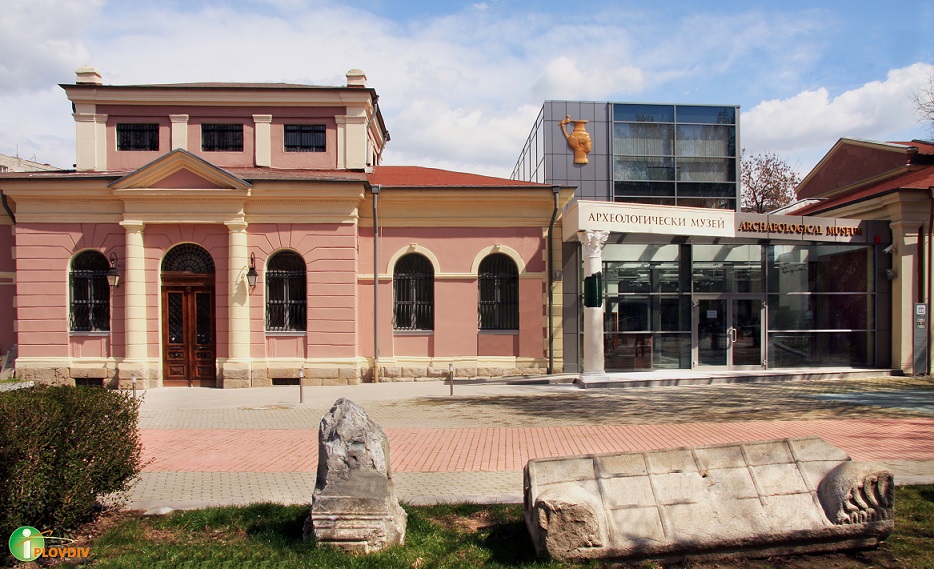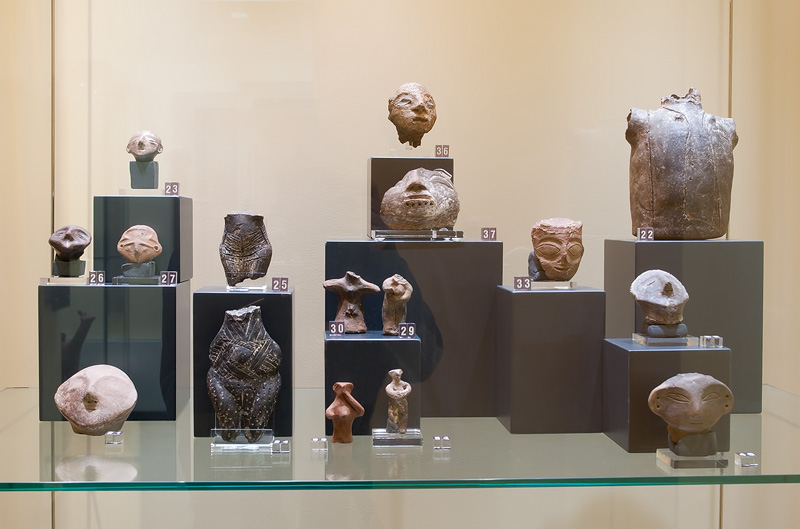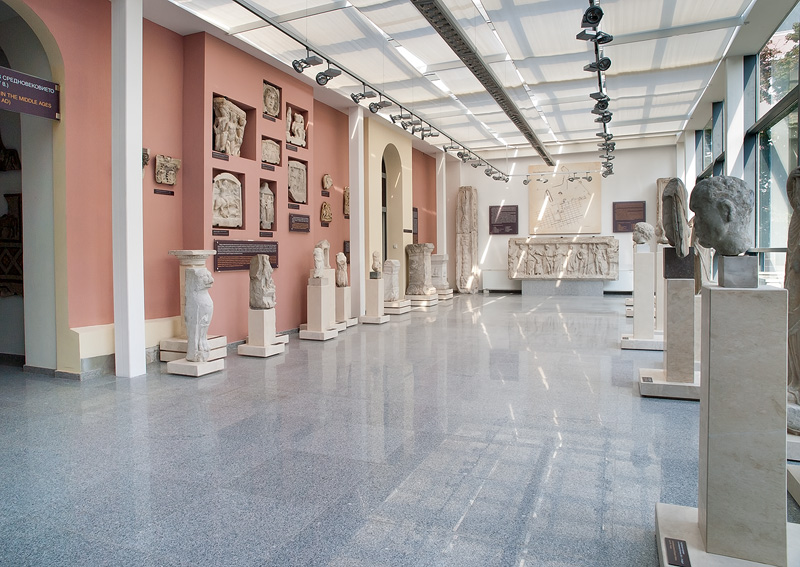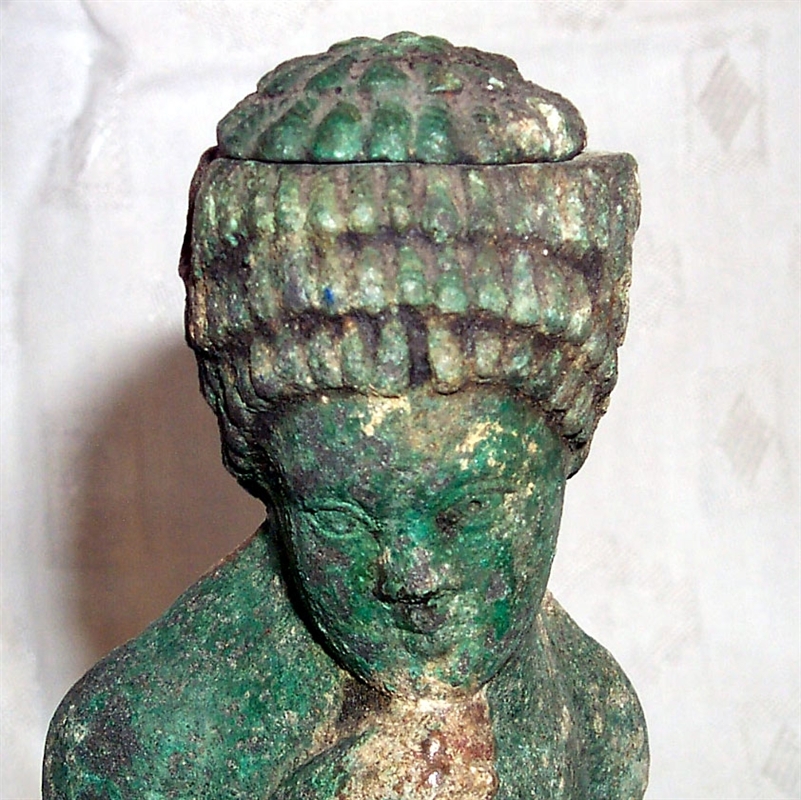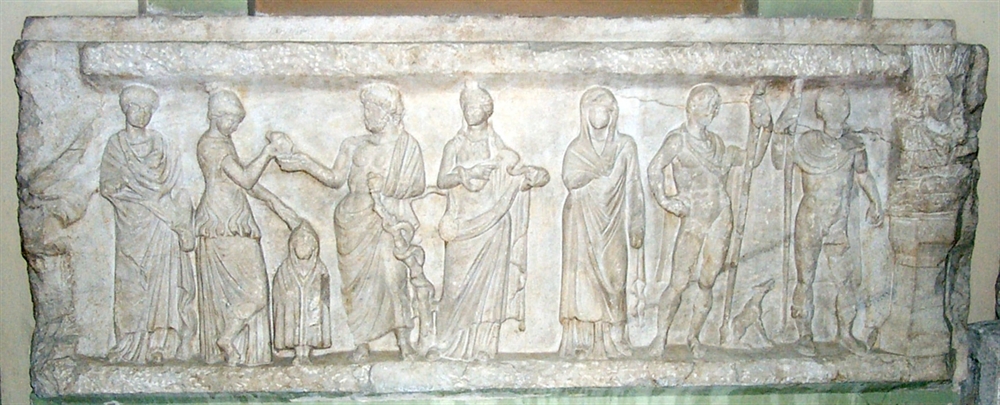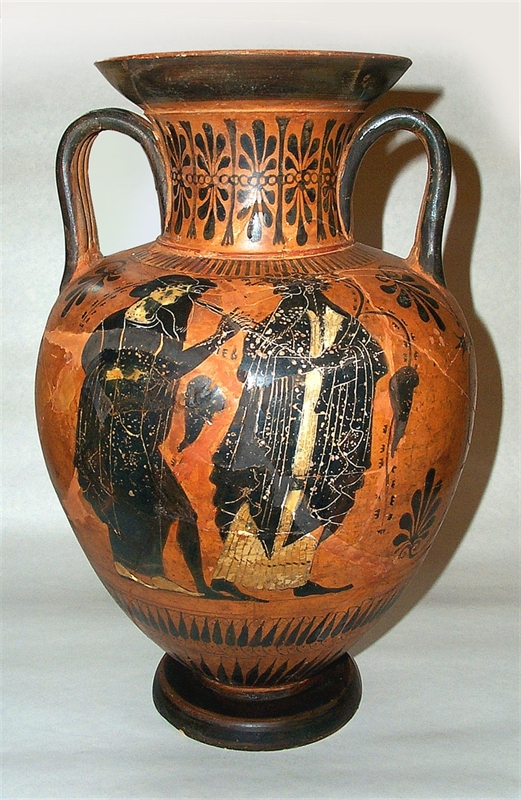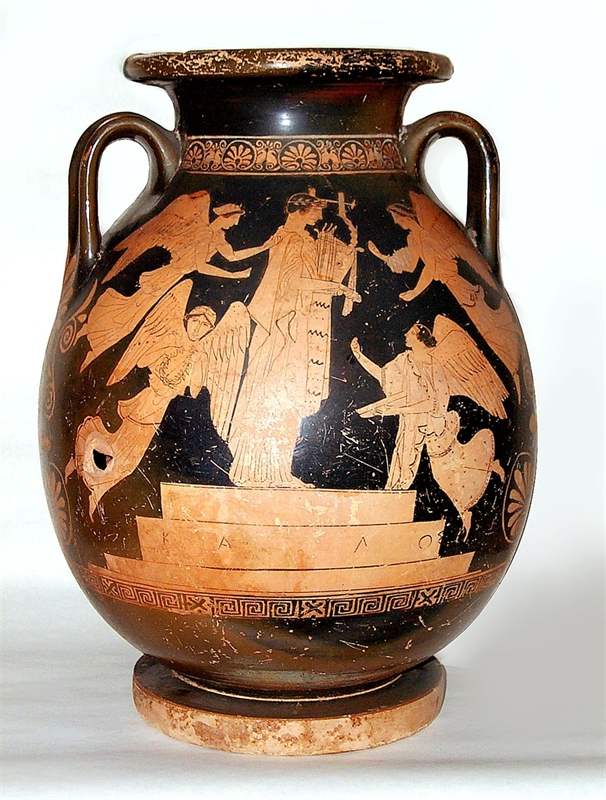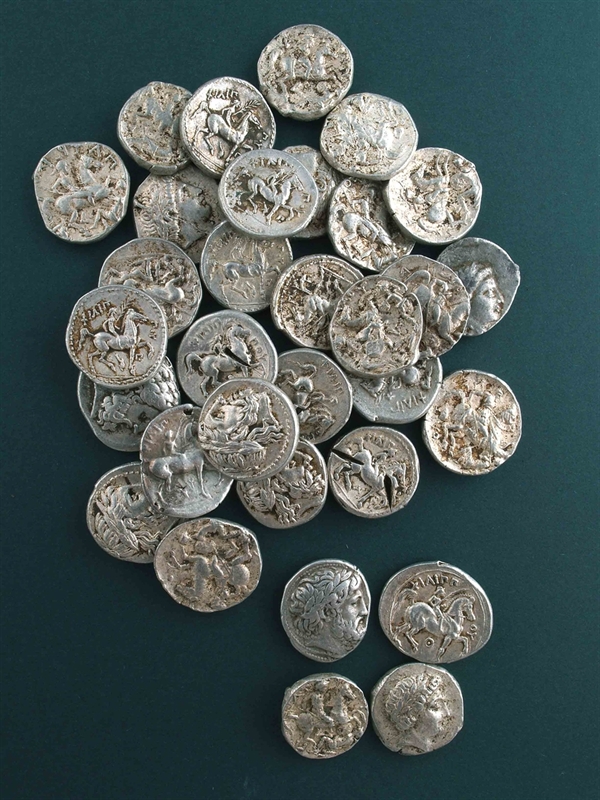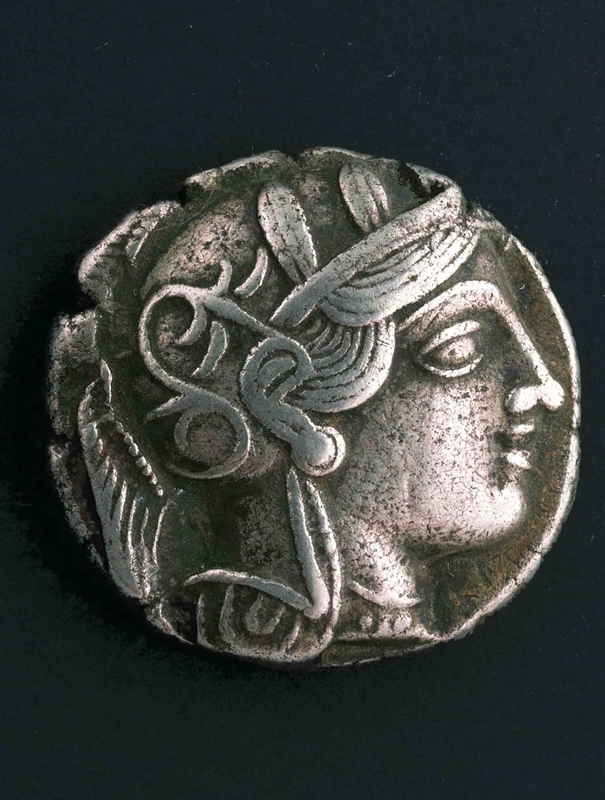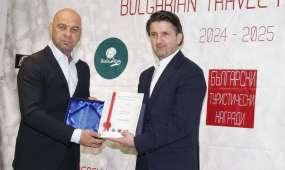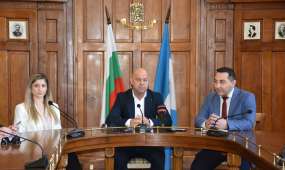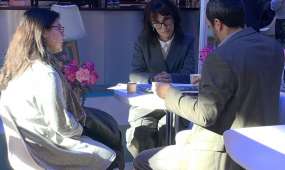Regional Archeological Museum
phone: +359 32 624 339 email: [email protected] link: https://archaeologicalmuseumplovdiv.org/_m1727/HomeFacebook: Regional Archaeological Museum - Plovdiv /@ram.plovdiv/
The Numismatic Department of Plovdiv Regional Archaeological Museum boasts a collection of 60,000 coins, dated VI c. B. C. - XX c. A. D. The department is constantly enriching its fund either through acquisition from various archaeological excavations or by buying out coins from private collectors.
The earliest coin emissions are represented by electrum and silver coins (archaic and classical type) cut out in the towns of Kyzikos, Athens and the Island of Thassos. They came into circulation in the Upper-Thracian Vallley in the period of VI - IV c. B. C., through the exchange of merchandise along the Maritza river valley and the road system in the Rhodope Mountains. The Numismatic Fund of the Museum treasures a considerable number of coins minted by various Thracian towns as well as by rulers and tribes, inhabiting the Aegean coast and the inner part of Thrace. It also contains imitations of the tetradrachms of Maroneia and the Island of Thassos, from II - I c. B. C., with decoratively depicted human and animal images.
The earliest coinages in the ancient Philippopol belong to the II B. C., when the town was called Odriza and produced bronze coins with the image of Heracles, the holly animal – bull and an inscription - WDRISWN.
A substancial part of the numismatic treasure of the Archaeological Museum is comprised of coins minted in the period of I - V c. A. D. Philippopolis was the first town in the inner part of Thrace that began to mint the so-called "pseudo-autonomous" bronze coins. The Emperors Domicianus (81 - 96), Trajan (98 - 117) and Hadrian (117 - 138) gave permission to the town to issue coins without the mediation of the Roman legates, temporarily governing Thrace. Alongside with the coins, the Museum collection holds a considerable amount of medallions, issued as commemorative signs to eminent representatives of the Emperor in the province or to town notables. In some periods they were also used as legal tender.
The minting of coins in Philippopolis in I c. A. D. began under the rule of Emperor Domicianus (81 - 96). Under the rule of different Roman emperors, the images on the coins and medallions minted in Philippopolis were generally related to the location, religion and history of the town in the period of I - V c. A. D. They represented deities worshipped by the Thracian people, such as: Bendida (also identified by the Greeks as Arthemis), Orpheus, Apollo Cendrisian, Eumolpius, Dionysus, as well as the Hebros river with boats sailing, the Rhodope mountains, and town-protecting deities. Coins and medallions representing scenes from the Alexandrian and Pythian games organized in the town during the reign of Caracalla (198 - 217) were also minted. Their inscriptions on the coins reveal that the games themselves were financed by the Thracian Union and province funds.
In the Middle Ages (VII – XV c.) Plovdiv continued to play a leading part in the historical development of Bulgaria as an economic, commercial and cultural center. The Numismatic Fund of the Museum holds collections of gold, electrum and bronze coins from that period, minted under the rule of different Byzantine emperors. These treasures were all found on the territory of Plovdiv and the region around it.
A collection of gold, silver and bronze Ottoman coins of different face values is an essential part of the Numismatic Fund. These coins, dating from the period of XV - XIX c., represent almost all Ottoman Sultans. The Numismatic Department also holds an impressive collection of West-European coins, typical for the period of XVI - XIX c., issued by different European rulers.
The Numismatic Department Fund also displays a coin collection, issued during the XX c. by official Bulgarian authorities.
The Regional Archaeological Museum in Plovdiv, Bulgaria (RAM – Plovdiv) is one of the first Bulgarian cultural institutions, officially opened in 1882. Originally set up as an archaeological and numismatic office, it gradually earned the status of Archaeological Museum during the 1920s.
Its funds initially consisted of a numismatic collection of 1,500 coins, ethnographic and historical documents, church plates, and incunabula from the VIII - XVII c., as well as 300 icons and paintings by some of the most famous Bulgarian painters Stanislav Dospevski, Ivan Lazarov, Tzanko Lavrenov, Nikolay Rainov, Zlatju Boiadjiev, and many others.
The Museum boasts one of the richest collections of 100.000 exhibits of artefacts related to the history of Plovdiv and its region. Plovdiv is the heir to one of the biggest and most famous ancient towns in the Balkan Penninsula - Philippopolis.
Prehistoric Art
The research on prehistoric times and art, commenced in the 1940s, has so far been carried out by several generations of devoted archaeologists. During that period about 25 multi-strata sites of the so-called "wire" type have been thoroughly studied.
The sites of "Yassatepe" in "Universitetski" quarter in Plovdiv; "Ploskata mogila" ("The Flat Burial Mound") situated in the village of Zlatitrap; the "Razkopanitza" burial mound in the village of Manole; the prehistoric settlement near the village of Muldava as well as the eneolithic cult complex near Dolnoslav village are all among the most significant Bulgarian prehistoric sites.
The extensive site research has been a perfect basis for studying the succession of pre-historical cultures (as well as their characteristic features) that originated in the Maritza river valley from the beginning of the Neolithic Age until the end of the Bronze Age. The Museum’s Pre-historic Fund consists of 4,800 exhibits classified in the following collections:
- Production tools made of stone, flint, bone or antler
- Plastic images (anthropomorphic and zoomorphic) made of marble, bones or clay
- Pottery dating from the Neolithic, Chalcolithic and Bronze Ages
- Copper and bronze tools and their casting moulds
- Jewelry and amulets
Thracian Art
The ethnoname "Thracians" denotes the multi-composite and multitudinous population that inhabited the territory up to the Carpathians on the north, reaching the Black Sea on the east, up to the Vardar river on the west and down to the Aegean Sea on the south. It was Homer who first mentioned the Thracians in line 434 of the Tenth song in his "Ilyad". That name is also found in various Cretan-Mycenaean written records.
Herodotus (V, II) wrote: "The Thracian ethnos is the most numerous one after the Indian. The Thracians are differently named in each separate region but the manners and customs of the whole nationality remain just the same everywhere."
The Thracian tribe called Odryssaes inhabited the region of Plovdiv in the V - I c. B. C. It was the only one among all the 46 known Thracian tribes that set upa form of government headed by a Royal institution. The Odryssian state included the present territory of Bulgaria, the northwestern part of Turkey and the northern regions of Greece. The representatives of the Thracian aristocracy were buried in huge mounds or stone sepulchres, of various layout, architecture and interior. The earliest sepulchres featuring cyst layouts and multi-colored paintings dating from V c. B. C. were found in the region of Kaloyanovo. They are related to the heirs of the first Odryssian tsar Teres I (480 - 440). Under the reign of the Thracian tsar Kotis I (383 - 359), in the beginning of IV c. B. C., the monumental masonry-built tombs with antechambers (dromos) and burial chambers equipped with a door for multiple visits were first introduced. Such kind of tombs were found in the vicinity of Perushtiza, Brestoviza and Plovdiv, as well as near the village of Starossel, Hissar region.
The Panagyurishte Gold Treasure
The Treasure collection, produced in the town Lampsakos in Asia Minor, consists of nine gold vessels with a total weight of 6.100 kg, discovered in 1949 near Panagyurishte. The gold beverage set includes a phiale (a dish) and eight rhytons (cups) in the form of different zoomorphic and anthropomorphic figures. The treasure used to be the possession of an unknown Thracian ruler of the Odryssian tribe who reigned at the end of IV c. and the beginning of III c. B. C.
Ancient Greek Art
The museum displays a rich and varied collection of ancient Greek works of art dating from V - IV c. B. C., found in the Odryssian kings’ burial mounds near the villages of Duvanli and Chernozem, in Kaloyanovo district. The Ancient Greek Art collection consists of black-and-red-figured ceramics produced in the Attic workshops as well as of silver objects (kantharoses, phiales and skyphoses) decorated with gilt figures and Greek Pantheon mythological scenes. The collection also includes gold jewelry objects for adorning feminine bodies and clothing.
Roman Art
The Antiquity Department of the Museum contains more than 5,000 exhibits divided into several collections illustrating the Thracian-Roman Arts.
Bronze Plastic Art Collection
The Bronze Plastic Art collection includes more than 200 bronze statuettes of idols worshipped by the Thracians in the period of I – IV c. The most numerous ones are the statuettes of the Thracian Rider, Hermes, Heracles, Telesphorus, Silenus, Fortunae, etc.
The Museum is in possession of over 100 bronze ornaments of chariots, pieces of furniture, as well as bronze vessels found in burial mounds all over Thrace. Those which provoke the greatest interest include the funeral bronze vessels from the site near "Kamenitza" in Plovdiv, dating from I c., also from the village of Voivodinovo in the region of Plovdiv, dating from II c., as well as the collections of Roman military diplomas and surgical instruments, dating from I – III c.
Ancient Sculptures Collection
The Ancient Sculptures Collection includes 50 marble portrait-heads from Philipopolis, some of which are statues of real-life people, found in the theatre and the big buildings, as well as torsos of idols worshipped in the various regions of Thrace.
The Museum also houses a part of the impressive marble plastic art objects used to decorate religious and civil buildings from I - IV c. - the theatre, the stadium and the town forum, as well as the main street with its rich colonnade near the eastern gate of Philippopolis - all elaborately decorated. The fund treasures a great part of the frieze-architrave, columns and capitals of the Ancient Stadium, as well as its entrance wall-piers decorated with objects related to Hermes and Heracles.
The most attractive among the town decorations is the frieze-architrave ornamented with the health-giving idols of Philippopolis, dating from III c.
The Museum keeps more than 1,000 exhibits from various sanctuaries in Thrace. The most valuable among them are those from the sanctuary of Asclepius Zemidrenetius near the village of Batkun, the Pazardzhik district, the sanctuary of Apollo Seulamenos near the village of Trud, Plovdiv region, as well as the unique tracery consecrated tombstone of Mithra Taurokton near the village of Kurtovo Konare in the region of Plovdiv.
Another museum collection includes tombstones, sarcophagi and epitaphs from the Philippopolis necropolises. The most valuable among those monuments are the tombstones from the Eastern necropolis, as well as the numerous sarcophagi from the Western necropolis.
Terracotta and Lamp Collection
Contains more than 500 Roman clay lamps made in the town, imitating the models of the famous Athenian lamp-makers Elpidephoros, Eutuches, Pireitos. An interesting cult utensil bearing the images of Zeus-Serapis and Dionysos also originates from the town.
Antique Mosaics Collection
The Collection contains predominantly mosaic panels from civil and religious buildings, with total surface area of 750 sq. m.
Mosaics in civil buildings
• Polychromatic mosaic bearing the emblem of "Eyrene" from a residential peristyled building built after the Gothic Invasion in 251.
• Polychromatic flooring bearing the emblem of "Narcissus", with dolphins in the corners, from a residential peristyled building, II c.
• Mosaic bearing the emblem of "Blue birds" from a residential building, II c.
• Polychromatic mosaic found in the apoditerium of a residential building with a bath, V - VI c.
• Two-layered polychromatic mosaic in OPVS VERMICVLATUM, found in nine rooms of the Termi Aqui, situated right under today’s "Kniaz Alexander" street, II - IV c. A. D.
• Wall mosaics and floorings of theTermi situated right under today’s "Yoachim Gruev" school, of an area of 2,5 decares (from the middle of III c. until the end of IV c.)
Mosaics in religious buildings
• Monochromatic mosaic, bearing the emblem of Menora and donors’ inscriptions from a synagogue, III - V c.
• Polychromatic two-layered mosaic with geometrical figured pictures of birds and Christian symbols from an episcopal 3-nave basilica, with atrium portici, partially revealed, V - VI c.
• Monochromatic mosaic from a residential complex, IV c.
• Marble mosaic tiling, featuring pictures of a deer and birds from a baptistery, V - VI c.
• Polychromatic mosaic from a martyrium - an early Christian building outside the fortified town, V - VI c.
Medieval Art
Written sources, historical research and archaeological excavations over the last 30 years have made it possible to build a fairly precise idea of what Medieval Plovdiv looked like. It used to be a major commercial, political, cultural and religious center in Thrace in the period of IX – XIV c. A. D. The urban planning is typical for that period. The medieval town is composed of an inner fortified part situated up on the Three Hills and some suburban quarters located down in the valley. The majority of all movable cultural monuments displayed in the Medieval Art Museum Section are found on the territory of Polvdiv and its region. The Medieval fund includes 1,270 inventory units classified according to their functions in various collections: labour tools, pottery, weapons, jewelry, religious objects,architectural elements, stone plastic art
Bulgarian Revival Art
Throughout the Bulgarian Revival period Plovdiv remained the biggest and most developed town in Bulgaria in terms of culture and economy. During that period the unique architectural ensemble of The Three Hills was created, alongside with a number of other valuable monuments of spiritual and material culture. The Regional Archaeological Museum displays rich collections of church plates, incunabula (early printed books), jewelry, belt buckles and belts, pottery and luxurious objects of high artistic value, dating from that period.
Numismatic Collection
The Numismatic Department of Plovdiv Regional Archaeological Museum boasts a collection of 60,000 coins, dated VI c. B. C. - XX c. A. D. The department is constantly enriching its fund either through acquisition from various archaeological excavations or by buying out coins from private collectors.
The earliest coin emissions are represented by electrum and silver coins (archaic and classical type) cut out in the towns of Kyzikos, Athens and the Island of Thassos. They came into circulation in the Upper-Thracian Vallley in the period of VI - IV c. B. C., through the exchange of merchandise along the Maritza river valley and the road system in the Rhodope Mountains. The Numismatic Fund of the Museum treasures a considerable number of coins minted by various Thracian towns as well as by rulers and tribes, inhabiting the Aegean coast and the inner part of Thrace. It also contains imitations of the tetradrachms of Maroneia and the Island of Thassos, from II - I c. B. C., with decoratively depicted human and animal images.
The earliest coinages in the ancient Philippopol belong to the II B. C., when the town was called Odriza and produced bronze coins with the image of Heracles, the holly animal – bull and an inscription - WDRISWN.
A substancial part of the numismatic treasure of the Archaeological Museum is comprised of coins minted in the period of I - V c. A. D. Philippopolis was the first town in the inner part of Thrace that began to mint the so-called "pseudo-autonomous" bronze coins. The Emperors Domicianus (81 - 96), Trajan (98 - 117) and Hadrian (117 - 138) gave permission to the town to issue coins without the mediation of the Roman legates, temporarily governing Thrace. Alongside with the coins, the Museum collection holds a considerable amount of medallions, issued as commemorative signs to eminent representatives of the Emperor in the province or to town notables. In some periods they were also used as legal tender.
The minting of coins in Philippopolis in I c. A. D. began under the rule of Emperor Domicianus (81 - 96). Under the rule of different Roman emperors, the images on the coins and medallions minted in Philippopolis were generally related to the location, religion and history of the town in the period of I - V c. A. D. They represented deities worshipped by the Thracian people, such as: Bendida (also identified by the Greeks as Arthemis), Orpheus, Apollo Cendrisian, Eumolpius, Dionysus, as well as the Hebros river with boats sailing, the Rhodope mountains, and town-protecting deities. Coins and medallions representing scenes from the Alexandrian and Pythian games organized in the town during the reign of Caracalla (198 - 217) were also minted. Their inscriptions on the coins reveal that the games themselves were financed by the Thracian Union and province funds.
In the Middle Ages (VII – XV c.) Plovdiv continued to play a leading part in the historical development of Bulgaria as an economic, commercial and cultural center. The Numismatic Fund of the Museum holds collections of gold, electrum and bronze coins from that period, minted under the rule of different Byzantine emperors. These treasures were all found on the territory of Plovdiv and the region around it.
A collection of gold, silver and bronze Ottoman coins of different face values is an essential part of the Numismatic Fund. These coins, dating from the period of XV - XIX c., represent almost all Ottoman Sultans. The Numismatic Department also holds an impressive collection of West-European coins, typical for the period of XVI - XIX c., issued by different European rulers.
The Numismatic Department Fund also displays a coin collection, issued during the XX c. by official Bulgarian authorities.
Day for free visit: Every first Thursday of the month for students and retired people.
The museum receives visitors in compliance with the anti-epidemic measures: https://archaeologicalmuseumplovdiv.org/_m1730/Information


